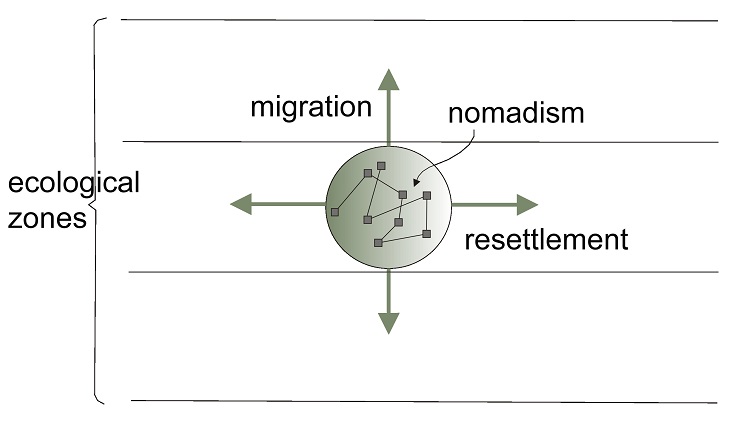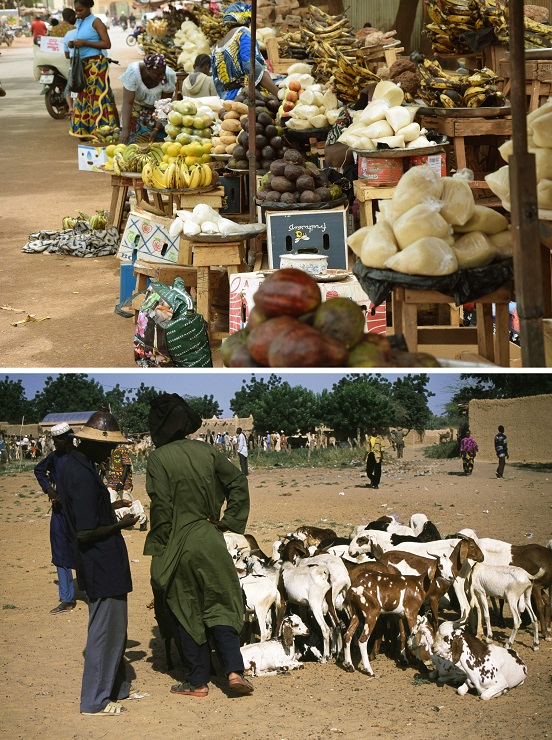When did the economic adaptation occur that tied humans tightly to herds of cows, horses, camels, sheep or goats? The original concept of social anthropologists was that this was a process parallel to that of the working specialisations of the Neolithic society, i.e. only subsequent to the formation of the Neolithic. The archaeologist Andrew Sherratt, in his concept defined as the “Revolution of Secondary Products” also related this process to the 4th and 3rd millennium BC, when animals, originally viewed as being nothing more than a reservoir of living flesh, were to become the sources of much wider range of products, e.g. hair to be processed into yarn and of milk and of dairy-products. Animals also started to be used for transportation and/or as pulling forces.
|
|
| The exchange of products between sedentary farmers and nomadic herders remains an integral feature of the existence of a variety of African populations. Photo above by Eliška Podgorná, Burkina Faso 2015. Photo below by Viktor Černý, Niger 2004. |
According to other researchers the pastoral economy was specifically linked to intensive agricultural production and cattle breeding, whereby in the search for a more profitable livelihood strategy, the agrarian and the pastoral economies were combined, or otherwise a society of this nature became entirely nomadic. Other researchers, especially amongst the archaeologists, have pointed out that the emergence of pastoralism occurred in parallel with the beginning of crop cultivation, or perhaps even preceded it.
Nomadic pastoralism, even simply in its verbal context, represents a dual concept thereby including two theoretically individual behavioural types: nomadism and pastoralism. Seasonally nomads could also be sedentary farmers or coexist with agricultural communities in a balanced symbiosis. Examples might be the Senegalese Fulani or the Turkana from East Africa who, though in terms of their subsistence largely depended on pastoralism, they also grew their own crops and, through trading, they also acquired a wide range of other agricultural products that they greatly appreciated in their diet. Pastoralism was also able to coexist with agriculture within a single residential community, whereby specialised social or ethnic groups focused on one or the other of these activities. Evidence is provided, for example, by the Syrian village Tell Toqaan, which was explored by the anthropologist Louise Sweet.
The specific term associated with herding nomads is transhumance. Generally speaking this was a cultural adaptation that enabled keeping cattle in areas that experienced a significant degree of seasonal fluctuation. In such areas hot and dry summers were typically alternated with cold and rainy winter intermezzos. The basic mechanism of transhumance was simple: in accordance with the current availability of grazing both the people and their cattle migrated locally to areas in which it was possible to feed their animals. This behaviour, however, was also partly dependent on the geomorphology, because in terms of the seasonal diversity of the pasture, the areas in which plains and mountains alternated had an advantage.
 |
| This diagram places emphasis on the direction of the geographic movements in conjunction with the number of crossed ecological niches and it also represents one of the attempts to pictorially define the categories that are associated with mobile pastoralism. Nomadism is illustrated here as a movement within a single ecological niche, while the migration crosses several of these niches. Relocation represents a specific type of migration, which, unlike the other two categories, takes place periodically. According to Ingold, 1987, 193. |
The problem of historical knowledge in regard to the pastoral nomads is their very low level of archaeological visibility. Attempts to distinguish a specific circuit of material sources that could be attributed solely to stockbreeders, usually ended in vain. The only potential clues remain the settlements, primarily in terms of their spatial dimensions and their type of structure. For interpreting remains of this nature it is also necessary to bear in mind the cultural patterns that are associated both with mobility and with large-scale stockbreeding.
The typical features of the nomadic economy are as follows: 1) people moved through the landscape with their cattle, for either short or long distances, in both vertical and horizontal directions; 2) the group identity of nomads was relatively unstable and both the sizes of their residential communities and their composition changed seasonally; 3) the individual households were autonomous, both in regard to their migration (when to move and to where) and their settling down (i.e. with whom to live there and how long for); 4) the natural trend of the frequent relocation of settlements also entailed having an all-encompassing flexible legal system associated with the use of land for grazing.
|
|
| The camp of nomads and its subsequent archaeological image. Photo by Petr Květina, Jordan, the Faynan region 2013. |
Want to learn more?
- Adriansen, H. K. 2008. Understanding Pastoral Mobility: The Case of Senegalese Fulani. The Geographical Journal 174 (3):207-222.
- Cribb, R. 1991. Nomads in Archaeology. Cambridge: Cambridge University Press.
- Dyson-Hudson, R., and N. Dyson-Hudson. 1980. Nomadic Pastoralism. Annual Review of Anthropology 9:15-61.
- Hole, F. 1978. Pastoral nomadism in western Iran. In Explorations in ethnoarchaeology, ed. R. A. Gould, 127-167. Albuquerque: University of New Mexico Press.
- Khazanov, A. M. 1994. Nomads and the Outside World. 2nd edition Madison: University of Wisconsin Press.
- Sherratt, A. 1981. Plough and pastoralism: aspects of the secondary products revolution. In Pattern of the Past: Studies in honour of David Clarke, eds. I. Hodder, G. Isaac, and N. Hammond, 261-305. Cambridge: Cambridge University Press.
- Stenning, D. J. 1959. Savannah nomads: a study of the Wodaabe pastoral Fulani of Western Bornu Province Northern region, Nigeria. Oxford: Oxford University Press.
 Archeologické 3D virtuální muzeum
Archeologické 3D virtuální muzeum

.jpg)

